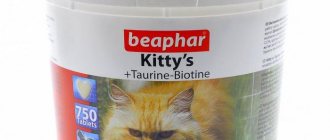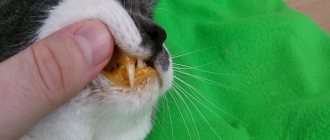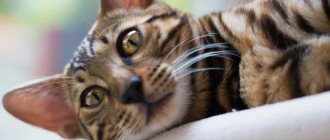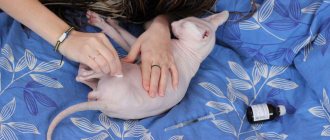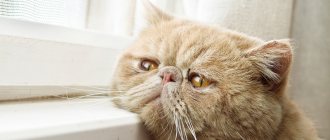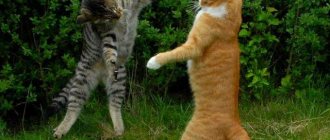Causes of a heart attack in a cat
As a rule, such reasons are associated with other diseases in the cat:
- Various congenital heart defects. The main anomalies leading to a heart attack are associated with pathology of the valvular apparatus of the heart.
- Heart rhythm disturbances.
- Genetically determined diseases of the vascular bed.
- Vasculitis is an inflammatory disease of blood vessels. A smaller amount of blood arrives from inflamed vessels to the myocardium. This leads to disruption of the nutrition of cardiomyocytes. Heart muscle cells cannot tolerate prolonged hypoxia. Ischemia of the cardiac muscle tissue occurs quickly.
- As an animal ages, changes in the structure of the myocardium may occur, which can also cause a cat to have a heart attack.
- Infection of a cat with helminths and blockage of blood vessels by them.
- If there was a blood clot somewhere in the pet’s vascular bed, it broke off and blocked the coronary artery - myocardial infarction is inevitable.
- Blockage of the arteries supplying the heart by emboli (an air bubble in the blood or a fat drop) will also lead to the death of myocytes.
- Diseases of the endocrine system (diabetes mellitus, hyperthyroidism) contribute to the occurrence of a heart attack.
- Infectious diseases in cats contribute to heart attacks. Especially if they are chronic.
- Loss of large amounts of blood, leading to severe anemia. In such a situation, myocardial trophism sharply worsens.
- Poisoning with pesticides, heavy metals and FOS also has a detrimental effect on the heart.
- Malnutrition of the cat, due to which plaques are deposited on the vessels.
- Chronic stressful situations.
Attention!
A fat cat with cheeks is a cute sight. But everything should be in moderation. You should not overfeed your cat if you do not want to get serious health problems in the future.
Reasons for development
The causes that provoke the development of myocardial infarction are conventionally divided into groups. Namely:
- The first group includes reasons associated with age-related changes in the animal’s body.
In young individuals, heart problems may arise due to hormonal imbalances and changes. As for older cats, a pathological condition can be caused by excessive physical activity that the heart of older animals cannot withstand.
- The second group includes reasons associated with violations of the diet and diet. Fatty and unhealthy foods lead to the accumulation of cholesterol in the cat's body. And it, in turn, settles on the walls of blood vessels, forming plaques, which complicate blood flow and begin oxygen starvation of cells. With prolonged and significant oxygen starvation, cells begin to die, and the risk of developing a heart attack increases.
- The third group includes problems associated with the formation of blood clots and diseases that provoke this condition. A detached thrombus completely blocks the lumen of the vessels, and the blood supply stops. In this case, myocardial infarction develops in a matter of seconds and the chances of saving the animal are simply minimal.
- The fourth group includes reasons related to the cat's health. The main ones are vascular diseases, especially of an infectious nature, as well as congenital pathologies and developmental anomalies.
Symptoms: When should you worry?
Not all cats are prone to coronary heart disease.
Most often, it affects cats that lead a sedentary lifestyle and love to eat a lot. Therefore, even if the cat lives in an apartment with little space, you need to play with it a lot so that it develops physically. Forays outside will also be useful.
You also shouldn't keep your cat stressed all the time. Animals really don’t like changing homes or owners. For them, just like for people, losing a loved one or furry friend is scary.
Care and nutrition
After returning home, the animal should rest more time and move less.
The success of therapy depends not only on the recommendations of the veterinarian and prescribed medications, but also on the owner who will care for the pet at home. After the heart attack has been suffered, the cat will need to create conditions of complete rest. The animal is sent to a quiet and dark room where it will not be disturbed by other pets or children. It is important to protect the cat from stressful situations. In addition, owners should ensure that the cat's activity is limited.
Veterinarian Andrei Gennadievich Komolov recommends walking the animal on the street, where the environment is calm and familiar. Walks should be short so that the animal does not get tired. In addition, you will definitely need to change the cat's diet. The menu includes foods that are easily digestible. It is forbidden to give cats fatty foods; it is better to avoid using dry food, which is sold in stores. The diet is enriched with fermented milk products.
If the kitten is small, it is acceptable to give it milk. For older animals, low-fat cottage cheese and sour cream are suitable. In addition, it is allowed to feed cats fish, but in limited quantities. Lean types of meat - chicken, beef - will be useful. You can add cereals to your diet, such as rice and buckwheat. You will need to cook them in weak broth or water. It is forbidden to give pets fatty meats, smoked meats, and sweet foods. If the veterinarian allows it, it is permissible to give the animal easily digestible complementary foods.
When should an owner worry that something bad has happened to his pet?
Clinical symptoms of myocardial infarction in a cat:
- The cat becomes excited and nervous. She rushes from corner to corner.
- Due to severe pain, the cat meows loudly and constantly. Sometimes even her usual “meow” is more like just a heart-rending scream.
- The pupils become sharply dilated even during daylight hours.
- The purr loses its appetite.
- Shortness of breath appears.
- The cat starts coughing.
- The cat begins to limp on the left side due to severe pain.
- If you try to listen to your pet's heart, it will pound. This phenomenon is called tachycardia.
- The mucous membranes become pale or even bluish.
Important!
If the slightest signs described above appear, you need to immediately take your cat to a veterinary clinic!
Treatment and care
Treatment of cats for this disease depends on the severity of the disease. Sometimes it is carried out exclusively during a daily stay in a veterinary clinic. Cats do not undergo heart surgery. During illness, they are prescribed only drug treatment. The earlier they are diagnosed with heart failure, the better their chances of survival. For recovery you need:
- Complete rest of the animal. The pet must be limited from any stress - this could be a working vacuum cleaner, traveling on public transport or the arrival of guests.
- Treatment with diuretics removes excess fluid from the body. During illness, fluid can accumulate near the lungs, thereby causing swelling. In the chest, causing pleurisy. In the abdominal cavity, causing ascites. Reducing the amount of fluid in the body helps reduce the load on the heart.
- Treatment with ACE inhibitors, which reduce the load on the heart by increasing blood flow.
- Positive inotropes make the heart pump more blood, control the heartbeat, and slow it down so it pumps more blood into the body.
- When the fluid content in a cat’s body is greatly increased, the veterinarian will pump it out and thereby remove it from the body. The cat will feel relief for a while, but this will not last long, as the fluid will return. Pumping is carried out by inserting a sterile needle into the required place.
- Balanced diet.
Heart failure in an animal requires careful care:
- Cats need low-salt food. Salt retains water in the body, which leads to poor circulation.
- Feed with a high content of taurine and protein.
- Heart failure requires regular veterinary consultations and ongoing treatment.
Diagnosis of myocardial infarction
A veterinary doctor can start thinking about myocardial infarction as soon as he sees the animal, since the symptoms are quite vivid and characteristic.
Thanks to instrumental diagnostic methods (echocardiography, electrocardiography), the veterinarian will carry out a differential diagnosis of a heart attack with other heart diseases that can cause similar symptoms, and will also check for brain diseases.
These are pathologies such as inflammatory diseases of the membranes of the walls of the heart (endocarditis, myocarditis, pericarditis, pancarditis), myocardosis, and various types of cardiomyopathy.
The distinctive features of a heart attack from any other heart disease on the ECG are:
- Pathological ST segment elevation.
- The growth of the Q wave is the main wave indicating the process of ischemia.
- Signs of bundle branch block appear.
An ultrasound can show interruptions in the functioning of the affected chamber of the heart (right and left ventricle).
Treatment of myocardial infarction in cats
Attention!
The only help that will be useful for a cat with a developing heart attack from the owner is to provide complete rest and safe transport to a veterinary clinic. Other attempts to do anything to the animal may result in its death.
A veterinarian or veterinary cardiologist prescribes the following therapy:
- The first thing to do is relieve pain. For this purpose, ketofen, a non-steroidal anti-inflammatory drug manufactured for use in veterinary medicine, is widely used;
- To improve heart function, nitroglycerin and its closest analogues are prescribed.
- To prevent thrombosis, antiplatelet agents and anticoagulants are used.
- To improve the rheological properties of blood, it is important to remove excess fluid. For this purpose, various diuretics are prescribed.
- To calm the animal after suffering stress, it is necessary to give sedatives. An inexpensive and effective representative are Kot Bayun drops. It is made on the basis of herbal ingredients, so it rarely causes severe adverse reactions and allergies.
- To help the functioning of the surviving cardiomyocytes, the cat should be given the vitamins and minerals that the heart needs (vitamin B6, potassium, magnesium and others).
In the post-infarction period, the cat needs to be provided with complete rest, care, proper nutrition, fresh air and its own shelter, where it can hide and be alone.
You can include kefir, yoghurt, and sugar-free milk porridge in your cat’s diet. Baby food is good for feeding a cat. You can give both infant formula and pureed meat with vegetables.
Among industrial feeds, it is better to give preference to premium feed lines. Dry food can be given only of high quality, purchased from a veterinary pharmacy.
Reference!
For variety, the porridge can be prepared with chicken broth. This delicacy will please the purring family member.
How is the treatment carried out?
Treatment of heart attacks in cats must be carried out under the close supervision of a physician. At the same time, the physician takes into account the signs of the disease that have arisen, the severity of its course and the presence of possible concomitant pathologies. First of all, the pet is prescribed medications that help relieve pain. For these purposes, a medicine called “Ketonal” is successfully used in veterinary medicine. Then medications are prescribed to prevent the formation of blood clots. Warfarin and Heparin will be effective in this situation.
After an attack, a cat often experiences swelling. To eliminate them, diuretic pharmaceuticals are prescribed. Furosemide is often used. To normalize the functioning of the heart muscle, Propranolol is used. Treatment of the disease cannot be done without sedative medications, which also help relieve the animal’s sense of fear. Mostly Fospasim is prescribed.
What are the correct living conditions for a cat that has had a heart attack?
- Complete peace. There is no need to once again let children near her, pulling her tail and mustache.
- Silence. A huge noisy party is not at all what an unhealthy ward craves.
- Fresh air. The room where the cat lives should be well ventilated. However, drafts at home are unacceptable.
- Proper nutrition.
- A cat should have its own dark corner.
- Stressful situations should be kept to a minimum. Let the worst thing for a cat be a trip to the veterinarian.
What should a cat's diet be?
- Industrial feed should not be of the mass market class (Kitekat, Whiskas, Felix and others). You should switch your cat to premium food (Hill's, Royal Canin, Purina Pro Plan and others) sold in veterinary pharmacies. They will be useful not only for the cat’s heart, but also for her entire body. Even dry food is unlikely to give your pet urolithiasis, the development of which is caused by cheap dry food.
- No matter how compassionate a cat’s eyes may be, you should never give her treats from the master’s table. It is especially worth excluding pork, lard, fried meat and fish from the diet of your favorite animal.
- Baby food is good for feeding.
Symptoms of heart problems
The difficulty in early detection of serious pathology of the heart muscle lies in the absence of characteristic clinical signs. In veterinary medicine, it is customary to treat a disease in stages.
The pre-infarction period is asymptomatic and only in rare cases can it manifest itself as signs of cardiovascular failure: shortness of breath, pallor or blue discoloration (cyanosis) of the mucous membranes, fatigue. The pet can breathe with an open mouth, which is unnatural for cats.
With the development of the most acute and acute stages, the clinical picture becomes more pronounced. Veterinary experts recommend that owners pay attention to the following symptoms in their furry pet:
- Pain syndrome. Due to severe chest pain, which develops as a result of necrosis of a section of the heart muscle, the cat becomes restless, nervous, and aggressive.
The state of excitement can be replaced by weakness and apathy. The cat screams a lot, meows, and sometimes screams heart-rendingly. The animal's pupils are dilated.
- When palpated, there is pain in the chest.
- Pain and discomfort in the left side of the chest lead to lameness in the animal.
- Impaired blood supply leads to pallor or a bluish tint to the visible mucous membranes (gums, mouth).
- No appetite.
- The animal loses orientation in space, the gait becomes uncertain and shaky. The cat lies down and reluctantly gets up.
- Not only the work of the heart is disrupted, but also the lungs. The cat has shortness of breath and heavy breathing.
- Arrhythmia, tachycardia.
At the subacute stage, pain disappears and symptoms fade away. The post-infarction phase is characterized by the formation of a scar and the adaptation of muscle tissue to work in conditions of decreased organ function.
Prevention of myocardial infarction
- From childhood, accustom your cat to active games. Let her run after a thread or a red dot from a laser pointer. The main thing is to let her run around as much as possible.
- Proper nutrition. There is no need to make the animal become obese.
- Do not expose your cat to severe chronic stress. Yes, cats are also worried about daily scandals at home, constant curses at them over trifles and beatings from their owners. If a cat eats sloppily, this does not mean that it should be physically punished immediately. After all, we can all knock over a plate or cup sometimes.
- Walking in the fresh air for about 30 minutes a day has a good effect.
Preventive actions
A house with toys will help your pet keep its heart healthy.
To prevent myocardial infarction in cats, it is important for owners to provide the animal with moderate physical activity in the fresh air. If you send your pet outside or you can’t go for a walk with him, you can set up a house for your cat with toys on the balcony. Playing with cat objects increases the load on the heart, making the heart muscle stronger and less susceptible to an attack.
An important preventative measure is the hygiene of the animal and keeping its tray clean. There are a variety of parasites in the cat's litter box, so it is important to clean it after each pet's bowel movement. In addition, the owner needs to diversify the animal’s diet and include foods containing sufficient amounts of vitamins and minerals.
Veterinarians advise giving cats boiled potatoes, legumes, fish and dairy products. The animal can also obtain useful substances from vitamin-mineral complexes, which are given in the spring and autumn. You can buy them in pharmacy chains. Owners should also regularly visit a veterinarian with their cat, which will allow them to identify any pathologies of the cardiovascular system at the initial stages of development, carry out their timely treatment and prevent the development of serious complications that can even lead to death.
Symptoms of a heart attack in a cat
